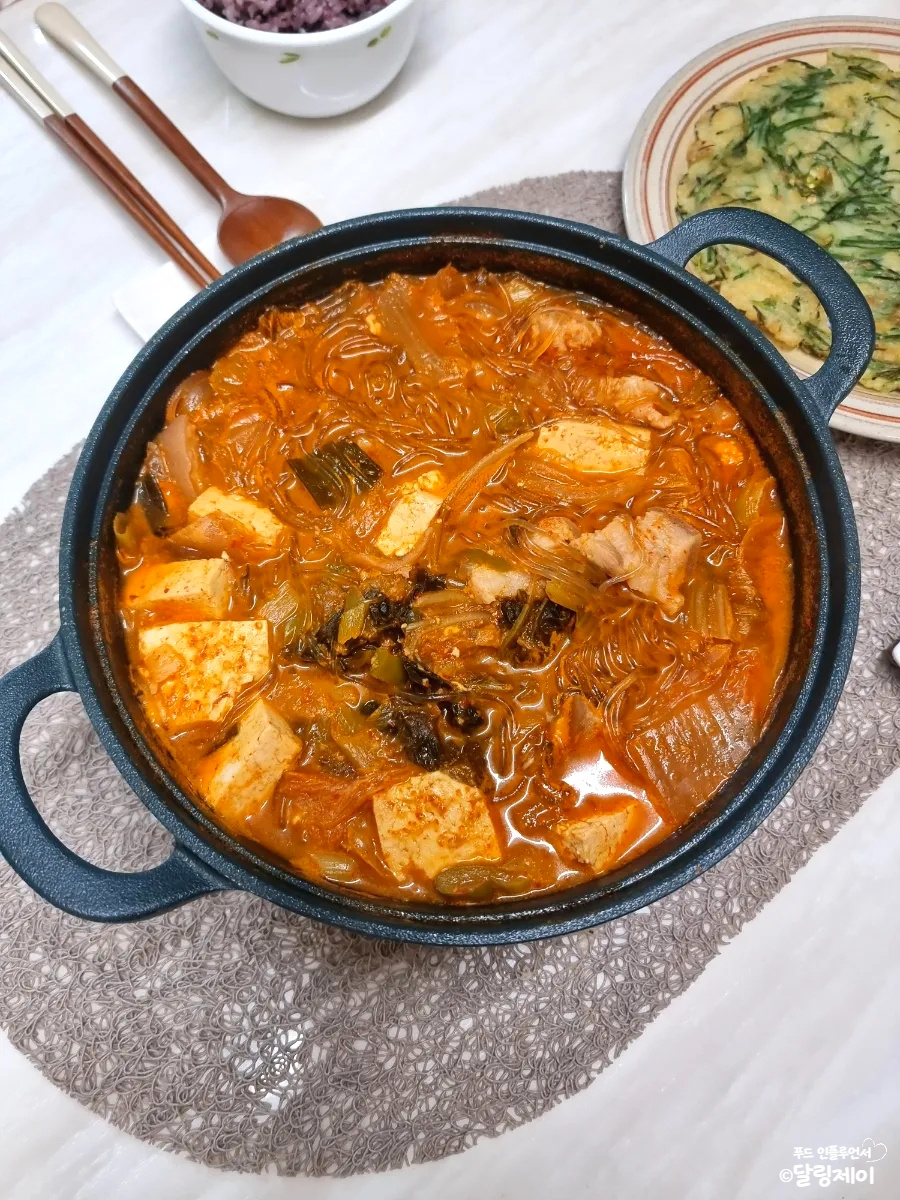Rich and Savory Bone Broth Kimchi Stew (Sagol Kimchi Jjigae)
The Ultimate Homemade Bone Broth Kimchi Stew Recipe for Deep, Savory Flavor

Don’t let that precious bone broth (sagol) in your fridge go to waste! Transform it into a deeply flavorful and savory Kimchi Stew. This recipe combines well-fermented kimchi (mukimchi) with tender pork and rich bone broth for an incredibly satisfying dish. Perfect for warding off the chill, this Sagol Kimchi Jjigae will warm your soul. Let me guide you through the detailed steps to create this ultimate comfort food!
Main Ingredients- Bone broth (100% beef, undiluted) 600ml
- Well-fermented aged kimchi 1 rice bowl portion (approx. 200g), chopped
- Kimchi brine 1 ladleful (approx. 50ml)
- Pork shoulder or front leg 300g (cut into stew-sized pieces)
- Tofu 1 block (cut into bite-sized pieces)
- Green onion (scallion) a small bunch (chopped)
- Cheongyang chili pepper a small amount (optional, sliced diagonally)
- Glass noodles suitable amount (soaked beforehand)
Cooking Instructions
Step 1
The most crucial first step! To achieve that deep, savory flavor, it’s essential to use undiluted 100% beef bone broth. Adding water can dilute the taste, so make sure to use only the bone broth. This is key to experiencing the true essence of Sagol Kimchi Jjigae.

Step 2
One of the secrets to a rich and savory stew! Add the pork from the beginning and let it simmer thoroughly. Instead of adding the meat halfway through or stir-frying it separately, cook it together with the bone broth right from the start. This allows the umami from the pork to meld with the broth, creating a significantly richer stew. Remember this secret for a deep Kimchi Jjigae broth – it’s a game-changer!

Step 3
Simmer until the pork shoulder or front leg is fully cooked. You can check for doneness by piercing it with a chopstick; if no pink juices emerge, it’s ready. Any impurities that rise to the surface will be skimmed off shortly.

Step 4
After confirming the pork is cooked, it’s time to add the well-fermented kimchi, kimchi brine, and the seasoning ingredients to start simmering the stew. The delicious aroma of the stew will begin to fill your kitchen soon.

Step 5
The foam that forms on the surface while simmering the pork can be visually unappealing and affect the clarity of the broth. Use a spoon to carefully skim it off. This step ensures a cleaner and more refined taste for your stew.

Step 6
Unlike clear anchovy broth, bone broth has a cloudy appearance, which might make the Kimchi Jjigae look different from the traditional red color. To enhance the color and flavor, we’ll add kimchi brine. A generous ladleful will add a spicy kick and a vibrant red hue, making it look as appetizing as it tastes.

Step 7
A rice bowl full of well-fermented kimchi is a good portion for two people. If you add too much, the sourness from fermentation might become overpowering, so use an appropriate amount.

Step 8
Keep the heat at medium and gently add the prepared kimchi to the pot. Let it simmer until all the ingredients begin to meld together.

Step 9
One tablespoon of minced garlic helps to eliminate any gamey odor from the pork, contributing to a cleaner taste. One tablespoon of red pepper flakes (Gochugaru) adds a spicy and hearty flavor, as well as the signature red color of Kimchi Jjigae.

Step 10
While the kimchi itself often provides enough saltiness, if you find the stew lacking in flavor, add half a tablespoon of soup soy sauce to adjust the seasoning. Taste the stew and adjust the seasoning as needed, being careful not to make it too salty.

Step 11
If the kimchi’s sourness is too pronounced, add one tablespoon of sugar to gently balance the tartness. Sugar not only tames the sourness but also enhances the overall savory depth of the stew.

Step 12
Once the Kimchi Jjigae has simmered for a while, add the pre-cut tofu and chopped green onions. Bring it to a boil again over high heat for a short period. This quick boil helps to preserve the fresh flavors of the added ingredients. For an extra spicy kick, you can add sliced Cheongyang chili peppers.

Step 13
For an even heartier and more delicious experience, try adding pre-soaked glass noodles! The chewy noodles absorb the flavorful broth, creating a delightful texture and taste. I often soak them beforehand and add them towards the end of cooking – they are truly delicious this way. You can also add other additions like rice cakes if you prefer.




